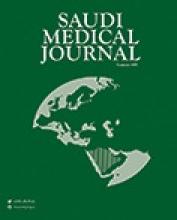Abstract
OBJECTIVE: To assess the knowledge and attitude of female students on medications in Al-Khobar city, the eastern province of the Kingdom of Saudi Arabia (KSA).
METHODS: The target population consisted of the third-grade intermediate, and all the 3 grades of secondary school female students in the Al-Khobar area, KSA. A multistage stratified sampling design was adopted at the end of 2001. At the first stage, 13 schools were selected, of which classes were selected in each level using a simple random sampling design. All students in the selected classes were included in the study. The total number of selected students was 1331 females.
RESULTS: The mean age of students was 16.1 + 1.7 years. Students from the government schools constituted 72.8%. Two-thirds of the students were in the secondary school grade. The Saudi single students constitute the majority. The study shows that self-administration of medications by female students was highly prevalent. Thirty-eight percent of the students have used over-the-counter (OTC) medications. Only 153 (11.5%) of the students used medications under medical supervision. Paracetamol was used as a painkiller during menstruation by a high proportion (576 students, 43.3%), while 43.5% used antibiotics during the previous year. Television was the main source of knowledge on medications and health. Age and knowledge of medication's side effects were the main variables found to be significantly associated with the use of antibiotics and OTC medications.
CONCLUSION: Self-administration of medication was widespread among adolescent girls. There is an immediate need to better understand, and improve the knowledge and medications usage in the schools.
- Copyright: © Saudi Medical Journal
This is an open-access article distributed under the terms of the Creative Commons Attribution-Noncommercial-Share Alike 3.0 Unported, which permits unrestricted use, distribution, and reproduction in any medium, provided the original work is properly cited.






